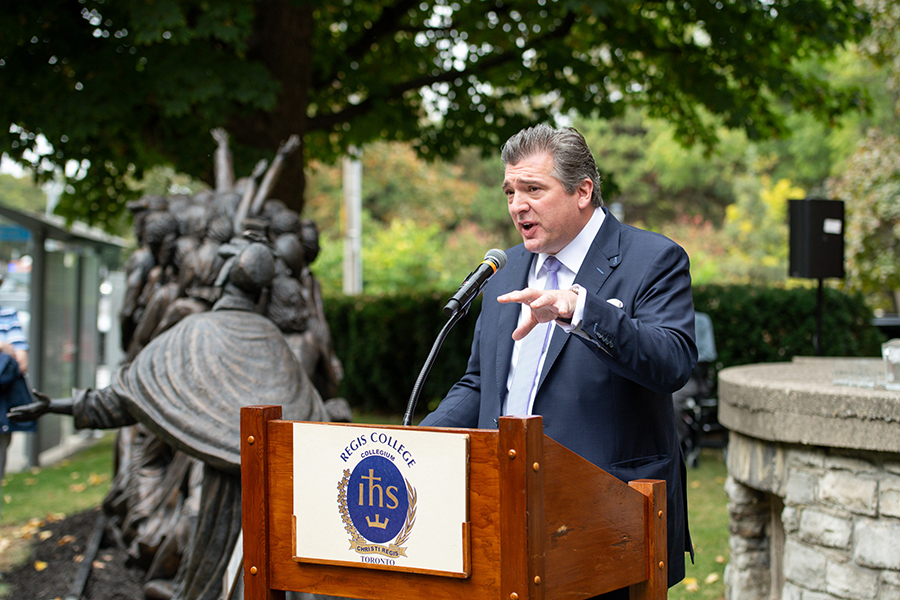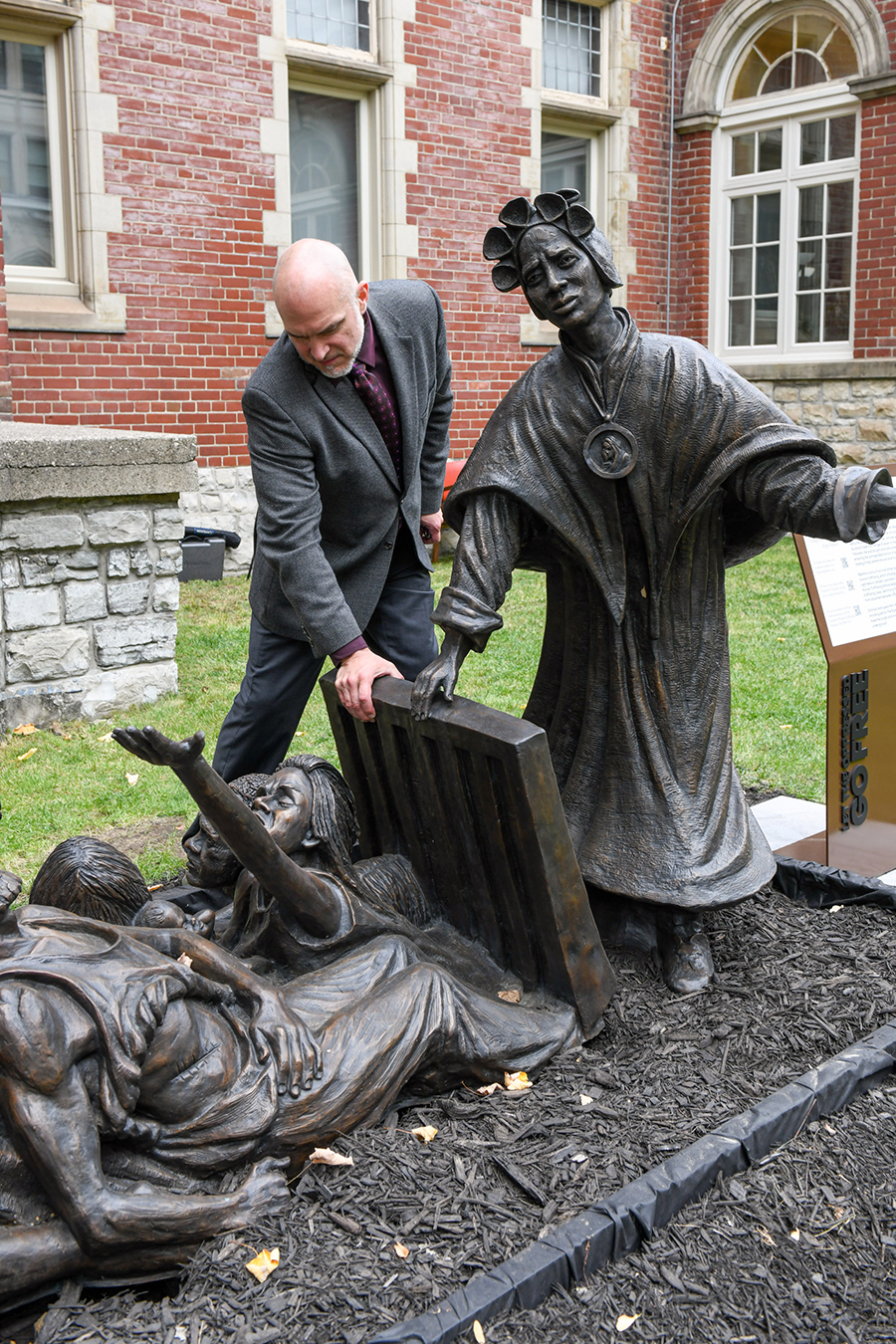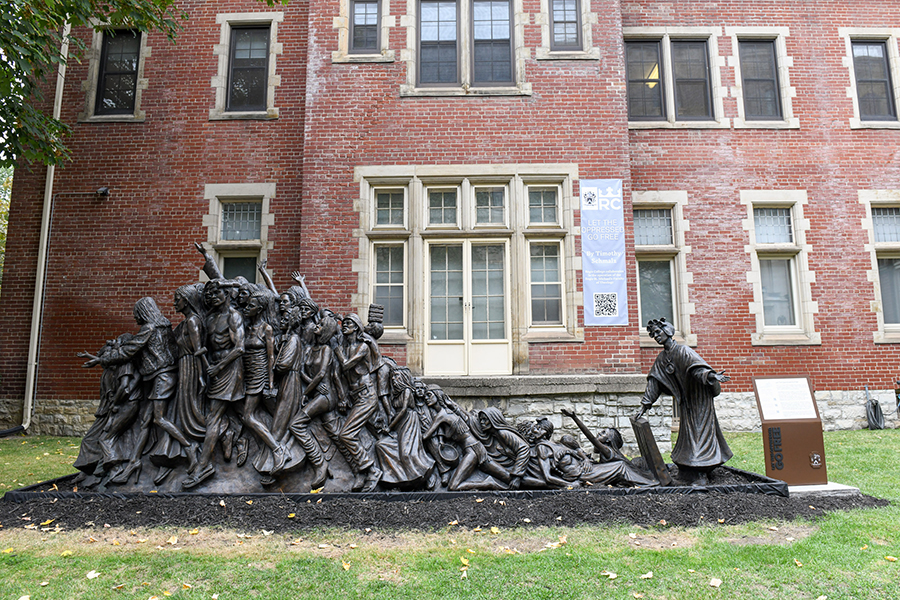Charitable Trinity: The Pope, a Real Estate Developer and an Artist Unite to Raise Awareness of Human Trafficking

The statue 'Let The Oppressed Go Free', by artist Timothy Schmalz, created at Pope Francis' request to shine a light on the issue of human trafficking. Photo: Courtesy of NKPRPhoto: Courtesy of NKPR
The first time Toronto real estate developer Christopher Bratty was asked to help cover the cost a bronze statue, the request came from Pope Francis. The second appeal came directly from Heaven.
Bratty is the president of The Remington Group, a major residential and commercial builder based in Toronto. He is also head of his family’s charitable effort, The Rudolph P. Bratty Family Foundation, which, through its philanthropic ties with the Catholic Church, was asked to help bring to life the Pope Francis-inspired statue that would represent the plight of migrants and refugees.
The grandson of Italian immigrants, Bratty felt this was a project he could really get behind. He agreed with Pope Francis’ notion that something was needed to counter the prevailing political sentiment in favour of building walls, closing borders and keeping people out. Plus, he was more than happy to work with Timothy Schmalz, an artist from Elmira, Ont. with whom he had collaborated on past projects.

That first statue — Angels Unawares — went up in the Vatican’s St. Peter’s Square in 2019. And it wasn’t long after that the Rome was inquiring whether Bratty would fund another — this one shining a light on the victims of human trafficking.
Bratty wasn’t nearly as enthusiastic the second time around. “Human trafficking seemed to me like too dark a problem that I wasn’t sure I wanted to know anything about,” he recalls. “And I didn’t feel it was an issue that affects Canada.”
He was about to learn two important lessons: 1) Human trafficking is indeed a major issue in Canada; 2) You don’t say no to the Pope, especially when he has divine intervention on his side.
Bratty points to the curious episode that helped change his mind. Not long after expressing reluctance to support the statue, he was stuck in a traffic jam in Toronto. A young woman jumped out of the back seat of a car ahead and started running for her life, with two men in hot pursuit. The police were called, the men were arrested and, sure enough, it turned out that the woman had been a victim of human trafficking.
With this heaven-sent message landing right on his lap, he couldn’t really say no to supporting the statue. “The Lord works in mysterious ways,” he concedes, noting that this experience made him realize just how “unenlightened” he had been on the this “heinous” issue. “It’s not a foreign problem — it’s in our cities and backyards.”

The Reality of Human Trafficking
Many of us are similarly unenlightened. Human trafficking is such a terrible crime, we try not to think about it in the hopes that it will go away. Public Safety Canada’s website describes human trafficking as “recruiting, moving, or holding victims to exploit them for profit, usually for sexual reasons or forced labour.” It’s a $150 billion-a-year global industry, making it the second most lucrative criminal enterprise, behind only drug trafficking. And while it’s illegal in every country, these modern-day slave traders are seldom brought to justice.
The Human Trafficking Institute, a U.S.-based body whose aim is to “decimate modern slavery” by working with police and prosecutors to stop traffickers, estimates that there are 25 million trafficking victims worldwide, four million of whom are involuntary sex-workers.
It’s hard to put a number on trafficking victims in Canada. Many of those affected are living here illegally or are unable — or simply too terrified — to come forward.
A Message of Hope
For the second statue, the Vatican asked Schmalz, the artist, to feature Saint Josephine Bakhita somewhere on the statue. As a child in Sudan, Bakhita had been bought and sold several times by Arab traffickers. In 1883, the teenage slave was bought by an Italian diplomat, who brought her back to serve him in Schio, Italy. Here, she was eventually freed, converted to Catholicism and joined a convent of nuns. Bakhita went on to become a much beloved figure in the city and was greatly admired for the care she provided locals during the bombings of the Second World War. In 2000, she was canonized by the Church and is now recognized as the patron saint of human trafficking victims.
Armed with St. Bakhita’s inspiration, the Pope’s blessing and Bratty’s financial backing, Schmalz began planning what would become “one of my most challenging works.” The 53-year-old art-school dropout, who specializes in large bronze outdoor sculptures — his “spiritual celebrations” — says that before designing this work he would stare for hours at the photos of trafficking victims, pushing himself to imagine that “deep, dark place that is the underground of every city in the world.”
The result was an overpowering 22.5-foot long, 3.5-ton bronze sculpture, the extraordinarily moving Let The Oppressed Go Free. The piece comprises 50 life-size representations of the faces Schmalz saw in those photos — the child brides, child soldiers, sex-traffic victims, domestic workers, miners, etc. “It’s a collage of how people are oppressed today,” says Schmalz.

While the subject matter is indeed dark, Schmalz says there’s an underlying message of hope. The victims are being released from the dark underground of oppression up through a grate that’s held open by the hero of the piece, St. Bakhita.
Schmalz made two casts of the statue — one was installed near the tomb of St. Bakhita in Schio and the other was recently unveiled in front of Regis College in downtown Toronto. Beside the statue is a stand with a QR code that links to information about human trafficking, as well as a hotline for those who suspect someone is a victim. (The Canadian Human Trafficking hotline, 1-833-900-1010, accepts tips from the public and connects victims with emergency and social services.)
Schmalz hopes that his piece will make the “invisible visual.” And Bratty feels that the cost of the project — which he says “ran into the millions” — will pay off down the road by raising awareness of human trafficking. He’s also pleased with the location, in downtown Toronto near the Queen’s Park provincial legislature building.
“I believe that if you shed some light on this crime and get people talking about it, you may be able to eradicate it,” says Bratty.
RELATED: